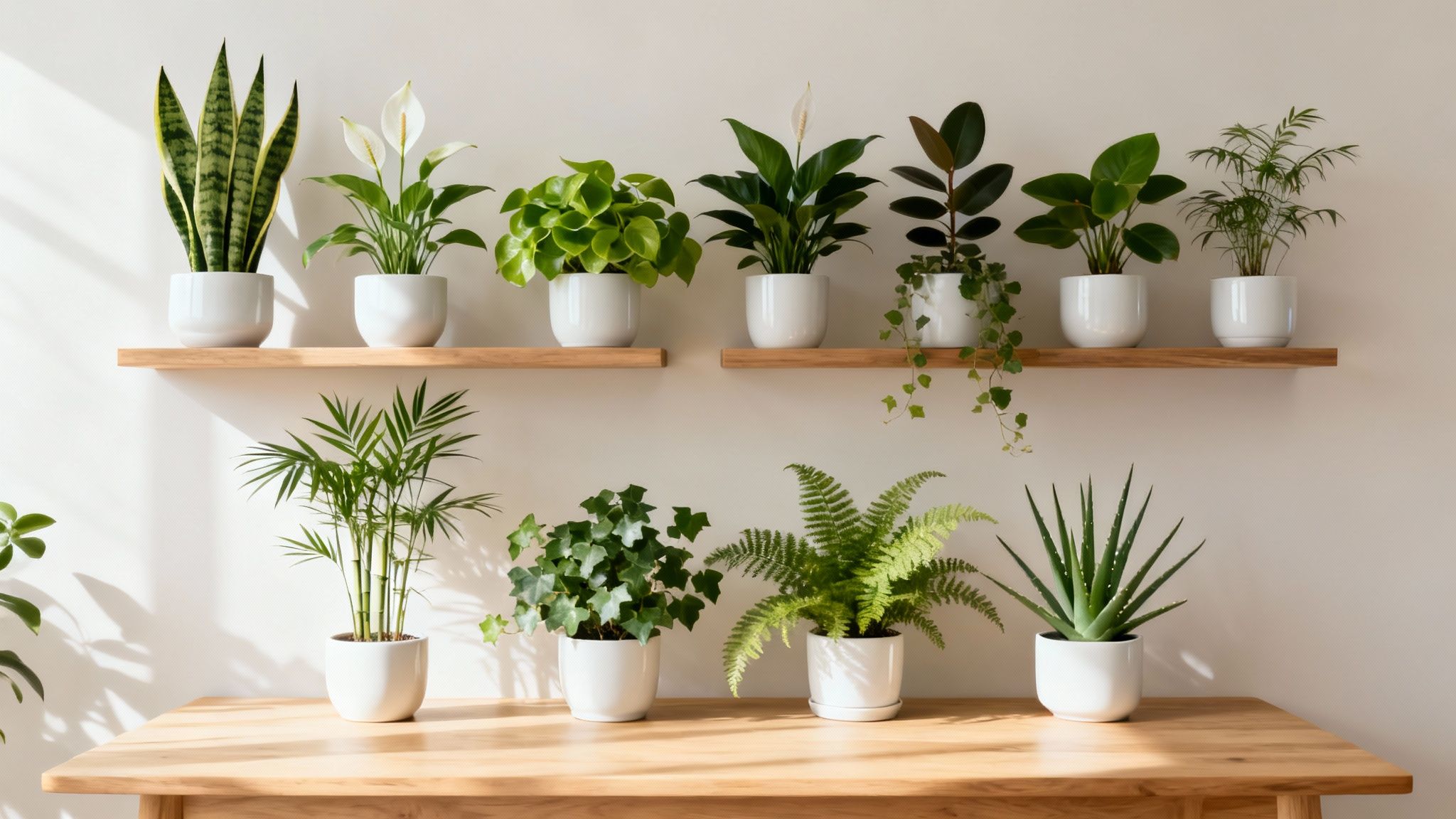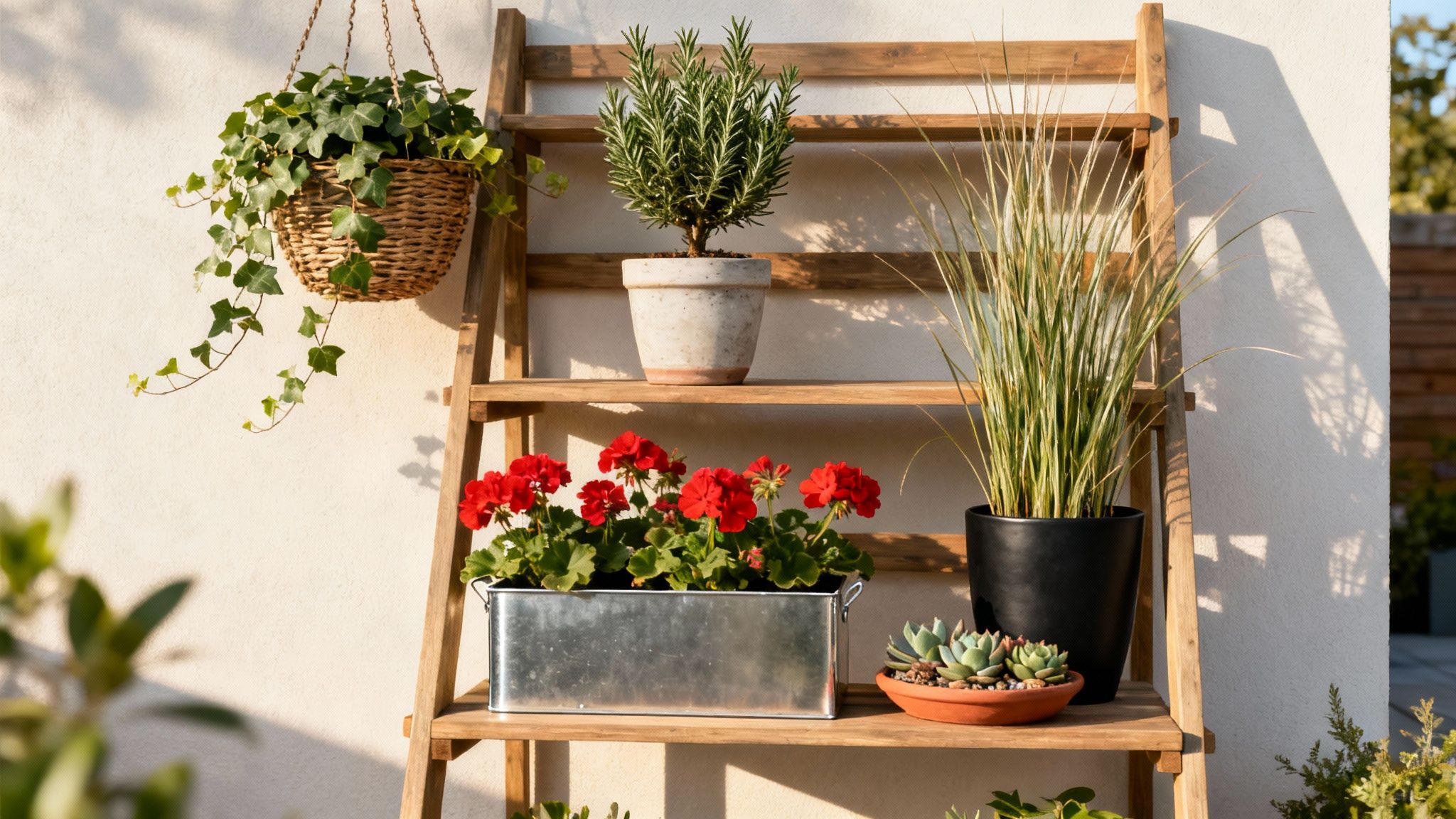In our modern, well-sealed homes, the air we breathe can be significantly more polluted than the air outside. Everyday items, from the paint on our walls to the furniture we sit on, often release invisible airborne toxins known as volatile organic compounds (VOCs). Common examples include formaldehyde, benzene, and trichloroethylene, which can contribute to a range of health issues.
While mechanical air purifiers offer a technological solution, nature provides a more aesthetically pleasing and sustainable alternative. Landmark research, including the NASA Clean Air Study, has demonstrated the remarkable ability of common houseplants to filter these harmful pollutants. These green allies work tirelessly, absorbing toxins through their leaves and root systems, while simultaneously converting carbon dioxide into fresh, clean oxygen and helping to regulate indoor humidity levels.
This guide moves beyond a simple list. We will provide a comprehensive roundup of the best indoor plants for air quality, detailing exactly which pollutants each one targets most effectively. You will find practical, actionable advice for every plant, covering everything from optimal lighting conditions and watering schedules to strategic placement for maximum air-purifying impact. Whether you are an experienced gardener or just starting your journey with houseplants, this curated selection will empower you to cultivate a healthier, more vibrant living space. Let's explore the perfect green companions to help you and your family breathe easier, one plant at a time.
1. Snake Plant (Sansevieria trifasciata)
The Snake Plant, also known as Mother-in-Law's Tongue, is a titan in the world of air-purifying houseplants. Its architectural, sword-like leaves make it a striking addition to modern minimalist interiors, but its true power lies in its exceptional ability to improve indoor air quality. It’s one of the few plants that convert carbon dioxide into oxygen at night, making it a perfect companion for bedrooms.
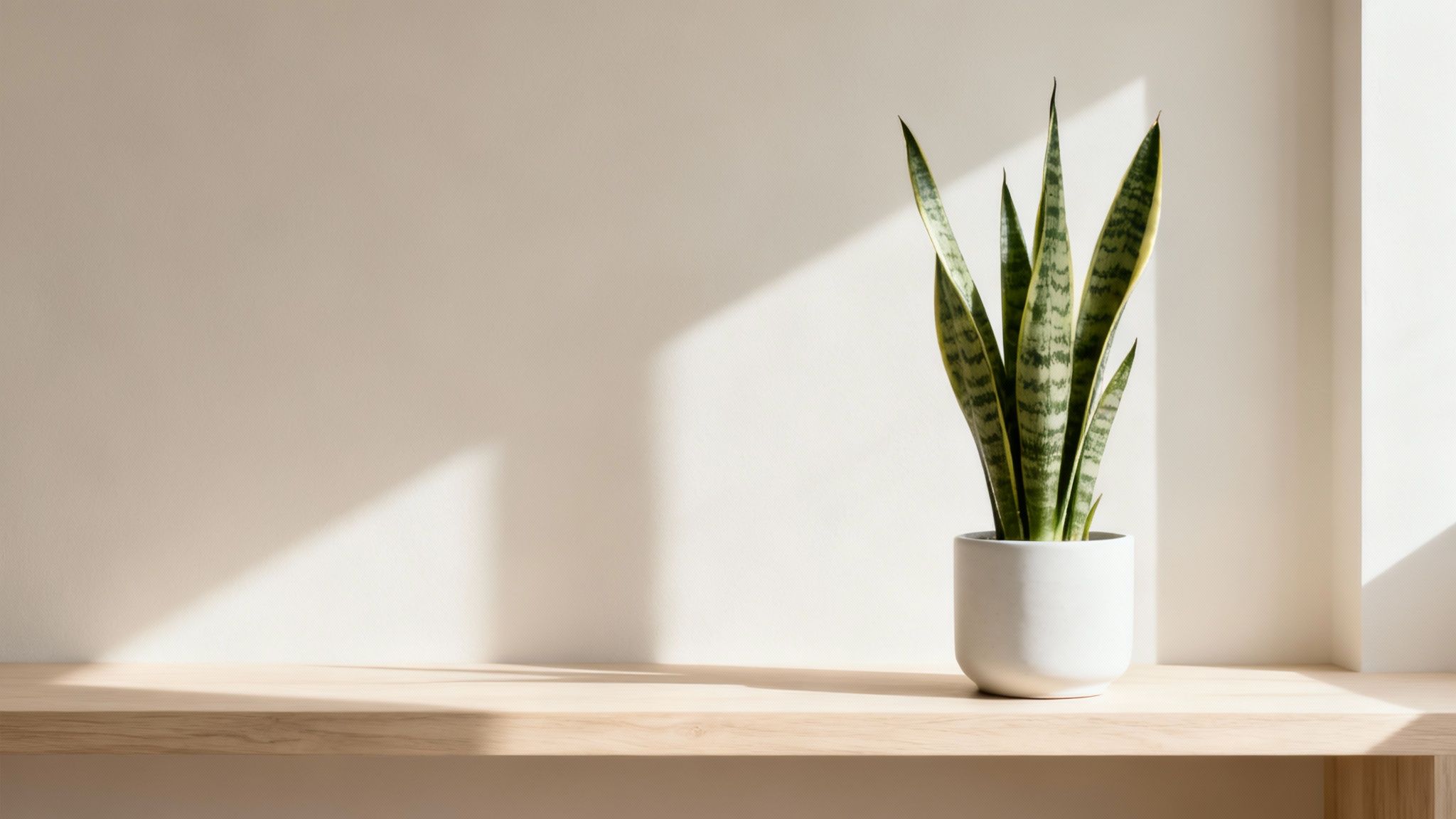
This plant’s reputation was solidified by NASA's Clean Air Study, which identified it as a top performer for filtering common household toxins. The Snake Plant effectively removes harmful volatile organic compounds (VOCs) such as formaldehyde, benzene, xylene, and trichloroethylene from the air. These pollutants are often found in everyday items like furniture, cleaning products, and synthetic fabrics. For a comprehensive look at how houseplants purify the air, you can explore the science behind the best houseplants for air purification on sprucecollective.co.uk.
Care and Placement Strategy
One of the key reasons the Snake Plant is considered one of the best indoor plants for air quality is its sheer resilience. It thrives on neglect, making it ideal for beginners or those with busy lifestyles.
- Lighting: While it tolerates very low light, it performs best in bright, indirect sunlight. This versatility allows placement in almost any room.
- Watering: This is a succulent, so it's crucial to let the soil dry out completely between waterings. Overwatering is the most common mistake and can lead to root rot.
- Placement: Position it near electronics or in room corners to help tackle stagnant air. Its upright growth habit makes it perfect for tight spaces.
- Maintenance: To maximise its air-purifying efficiency, gently wipe the leaves with a damp cloth once a month to remove any dust build-up. This ensures the leaf pores (stomata) remain clear to absorb airborne toxins effectively.
2. Spider Plant (Chlorophytum comosum)
The Spider Plant is an incredibly popular and adaptable houseplant, celebrated not only for its graceful, arching leaves and charming baby "spiderettes" but also for its remarkable air-purifying capabilities. It is one of the easiest and most forgiving plants to grow, making it a fantastic choice for both novice and experienced plant owners. Its non-toxic nature also makes it one of the safest and most effective natural air filters for homes with curious pets and children.
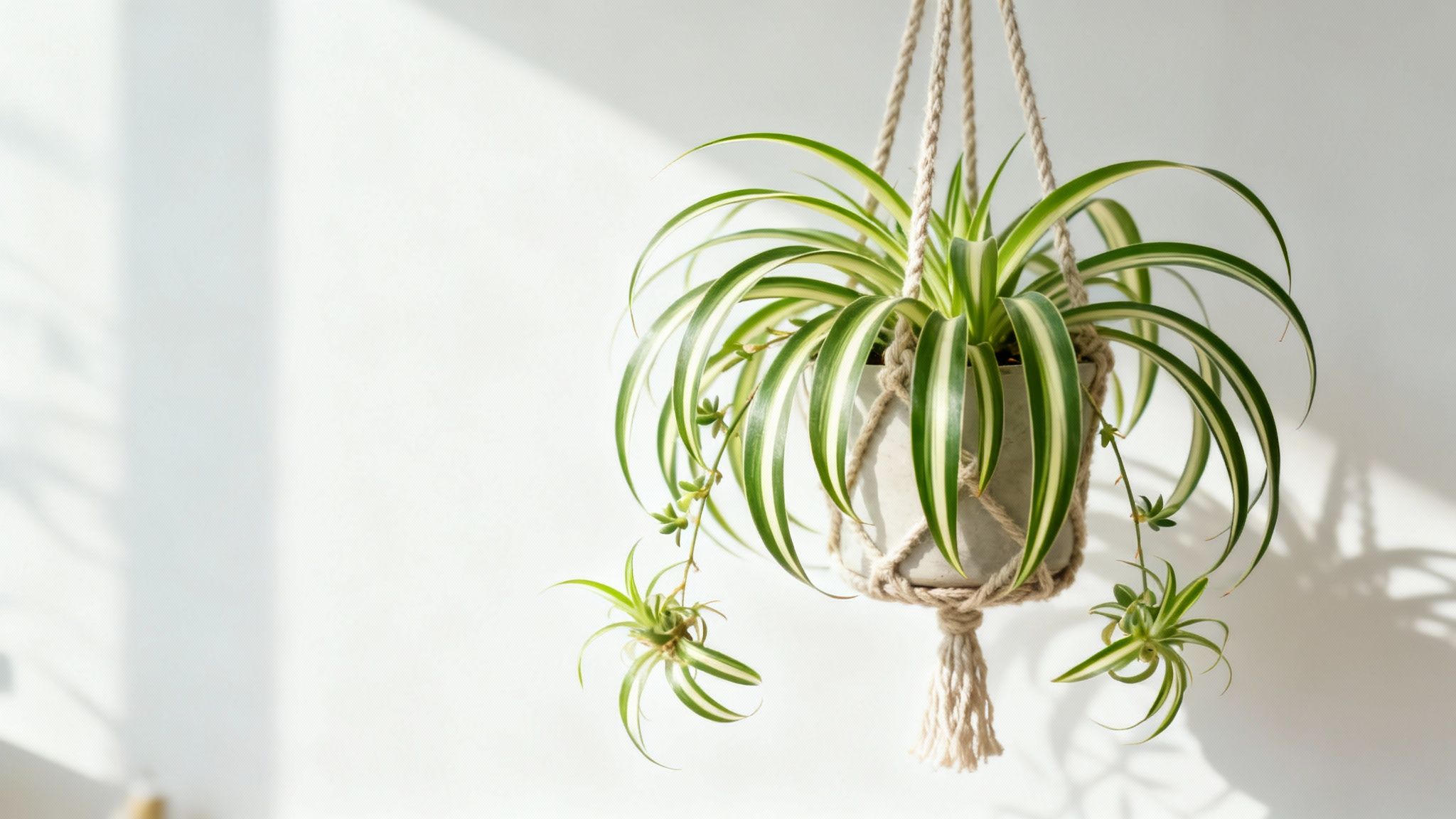
Similar to the Snake Plant, the Spider Plant was featured in NASA's Clean Air Study, where it demonstrated an impressive ability to remove harmful toxins from the atmosphere. It is particularly effective at filtering formaldehyde and xylene, two common VOCs emitted from materials like adhesives, paints, and furniture. This makes it an ideal plant for newly decorated or furnished spaces, actively working to create a healthier indoor environment. For an in-depth guide on keeping this plant happy, you can explore detailed spider plant care on sprucecollective.co.uk.
Care and Placement Strategy
A key reason the Spider Plant ranks among the best indoor plants for air quality is its low-maintenance and resilient character. It communicates its needs clearly and thrives with minimal intervention, all while diligently cleaning the air.
- Lighting: It flourishes in bright, indirect light, which encourages vibrant foliage and the production of its iconic plantlets. However, it can adapt to lower light conditions.
- Watering: Water thoroughly when the top two inches of soil feel dry. Using filtered or distilled water can help prevent brown leaf tips, which are common due to sensitivity to chemicals in tap water.
- Placement: Its cascading growth habit makes it perfect for hanging baskets or placed on shelves where its foliage can drape freely. This elevated placement also helps to purify air at different levels within a room.
- Maintenance: Propagate the baby plantlets by placing them in water or soil to easily create new plants. Wiping the leaves down occasionally will keep them free of dust and ensure they are absorbing toxins efficiently.
3. Peace Lily (Spathiphyllum wallisii)
The Peace Lily is celebrated not only for its elegant white spathe flowers but also for its powerful air-purifying capabilities. This graceful plant brings a touch of sophisticated calm to any room while diligently working to cleanse the environment. Its broad, dark green leaves are highly efficient at absorbing airborne toxins, making it a functional and beautiful addition to homes and offices.
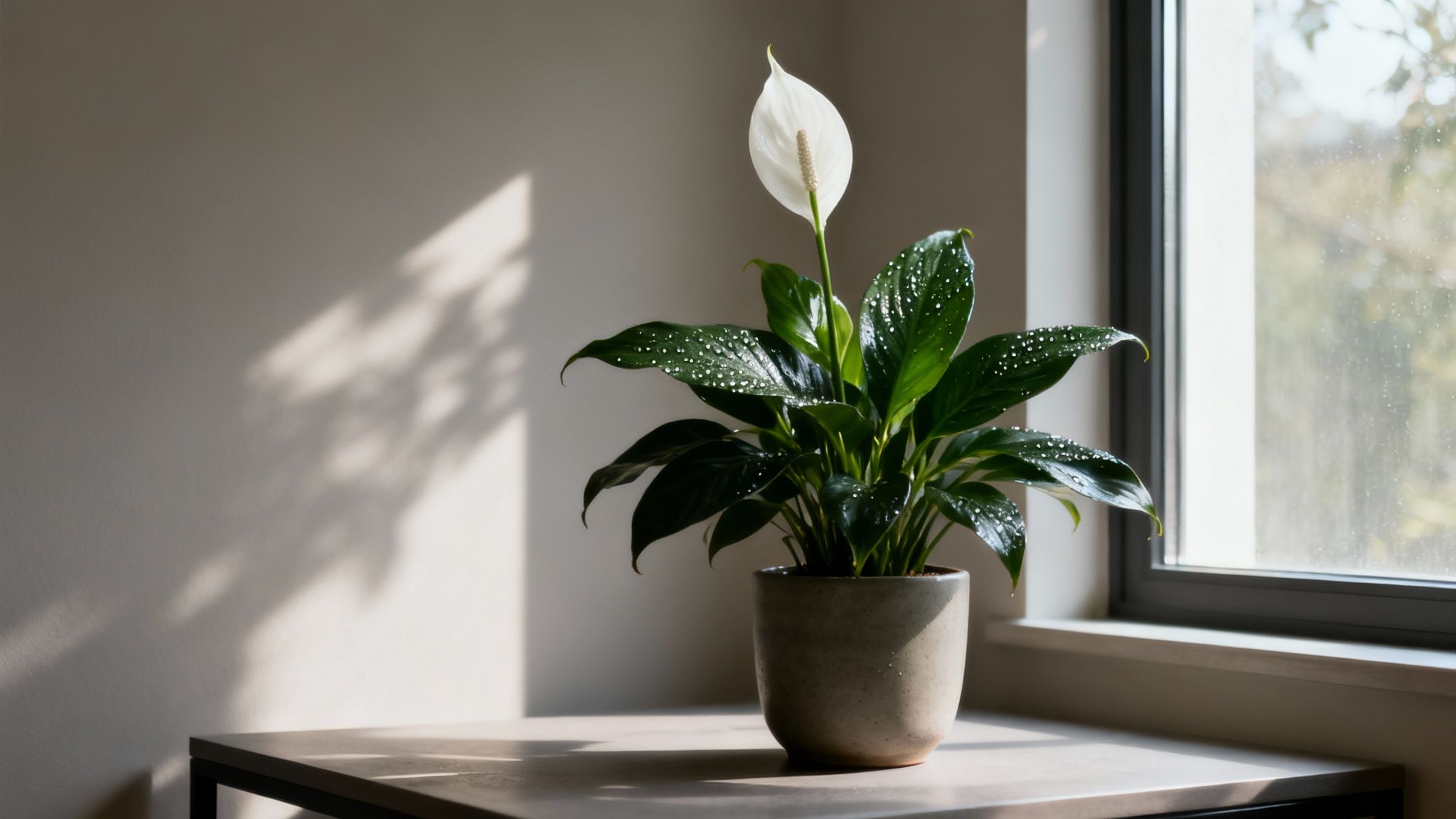
Also a distinguished graduate of NASA's Clean Air Study, the Peace Lily is proven to neutralise a range of harmful volatile organic compounds (VOCs). It is particularly effective at removing ammonia, a chemical commonly found in household cleaners, as well as benzene, formaldehyde, and trichloroethylene. This makes it an exceptional choice for placement in kitchens and bathrooms where these pollutants are often concentrated. Its popularity among interior designers for corporate and healthcare settings stems from this blend of aesthetic appeal and tangible health benefits.
Care and Placement Strategy
The Peace Lily's communicative nature makes it one of the best indoor plants for air quality for both novice and experienced plant owners. Its tendency to visibly wilt when thirsty provides a clear, unmistakable signal that it needs water, taking the guesswork out of its care routine.
- Lighting: It thrives in medium to low indirect light, making it perfect for shaded corners or rooms with less natural sunlight. Avoid direct sun, which can scorch its leaves.
- Watering: Water thoroughly when the plant begins to droop, but do not let it sit in a waterlogged saucer. Using filtered or distilled water can help prevent the leaf tips from turning brown.
- Placement: Position in living rooms, bedrooms, or offices where its air-purifying qualities can be maximised. Its high transpiration rate also helps to humidify the air.
- Maintenance: Gently wipe the leaves with a damp cloth every month to remove dust, which enhances their ability to absorb light and airborne toxins. Prune away spent flowers at the base of their stalk to encourage new blooms and redirect the plant's energy.
4. Boston Fern (Nephrolepis exaltata)
The Boston Fern is a timeless classic, celebrated for its graceful, feathery fronds that create an immediate sense of lushness and vitality. More than just a beautiful decorative plant, it is a powerhouse of air purification, highly effective at removing airborne pollutants. Its ability to act as a natural humidifier also makes it a fantastic choice for improving overall indoor comfort.
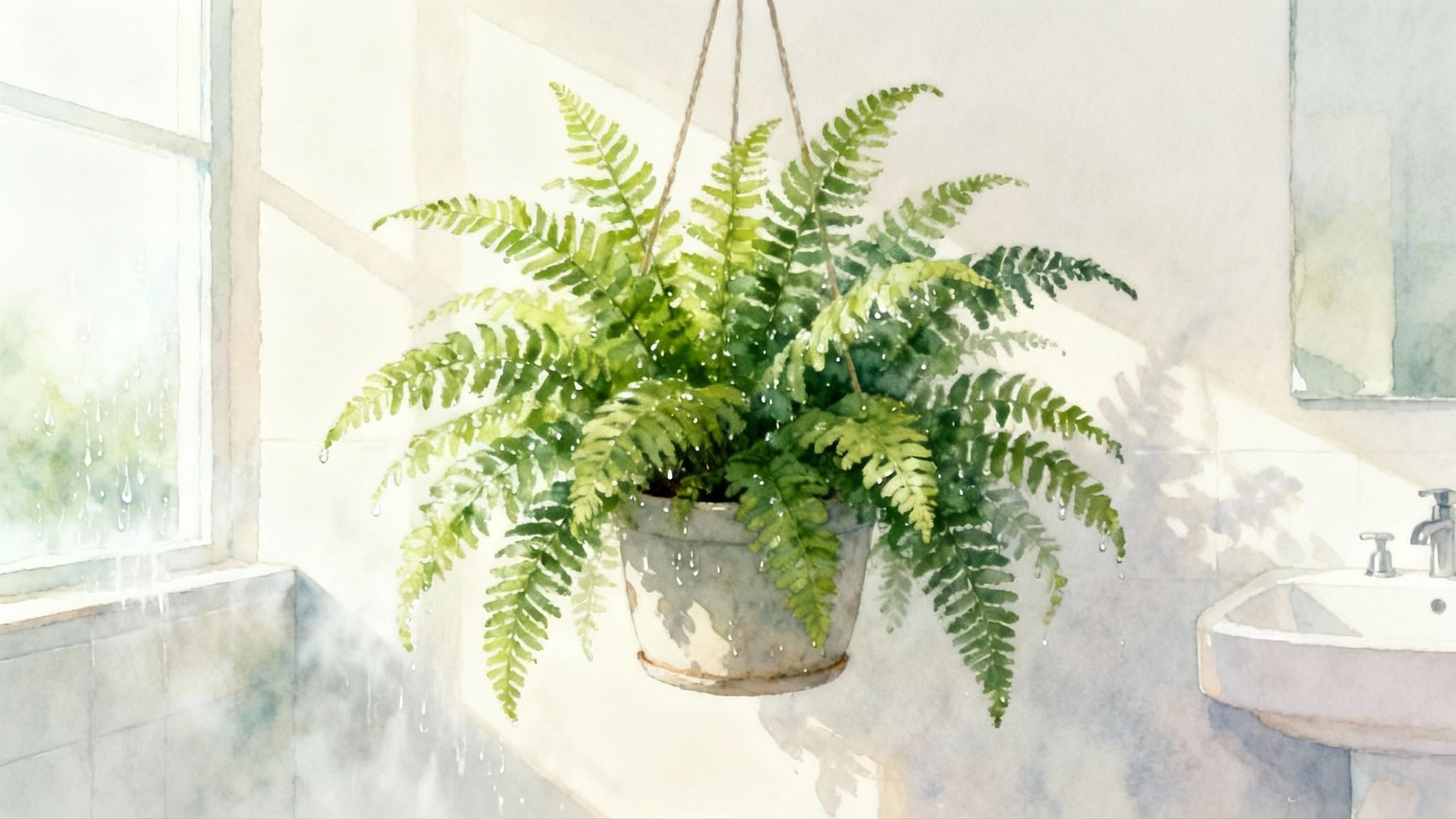
Popularised during the Victorian era and confirmed for its efficacy by NASA's Clean Air Study, the Boston Fern excels at filtering formaldehyde and xylene from the atmosphere. These common toxins are often off-gassed from pressed wood products, furniture, paint, and household cleaners. By adding a Boston Fern to your home, you are introducing one of the most efficient natural air scrubbers available, making it one of the best indoor plants for air quality, especially for those with sensitivities.
Care and Placement Strategy
The key to a thriving Boston Fern is recreating its native humid, woodland environment. While it requires more attention than a Snake Plant, its air-purifying rewards are well worth the effort.
- Lighting: It prefers bright, indirect light. A spot near an east-facing window is ideal, as direct sunlight can scorch its delicate fronds.
- Watering: The soil should be kept consistently moist but never waterlogged. Check the soil every few days and water thoroughly when the top inch feels slightly dry.
- Placement: Its love for humidity makes it a perfect fit for bathrooms and kitchens, where it will happily absorb excess moisture. Feng Shui practitioners also recommend it for creating a sense of balance and calm.
- Maintenance: To keep your fern at its peak, mist its leaves daily or place it on a pebble tray filled with water. A monthly shower helps remove dust from the fronds, allowing them to breathe and purify the air more effectively.
5. Bamboo Palm (Chamaedorea seifrizii)
The Bamboo Palm, with its elegant, arching fronds and slender, bamboo-like canes, brings a sophisticated tropical feel to any interior. Beyond its aesthetic appeal, often seen gracing corporate lobbies and luxury hotels, this plant is a powerhouse in air purification. Its ability to create a lush, vibrant atmosphere is matched by its talent for cleansing the air you breathe.
Popularised by NASA's Clean Air Study, the Bamboo Palm is celebrated for its efficiency in filtering out airborne toxins. It is particularly effective at removing formaldehyde, benzene, and trichloroethylene, volatile organic compounds commonly off-gassed from furniture, paints, and cleaning agents. Its dense foliage acts as a natural air filter, making it a valuable addition to homes and offices. Integrating plants like the Bamboo Palm is a core principle of biophilic design, which focuses on connecting our indoor spaces with nature to improve well-being. You can explore how to create healthier, more nature-inspired interiors by understanding what biophilic design is on sprucecollective.co.uk.
Care and Placement Strategy
Maintaining the Bamboo Palm’s health is key to its purifying performance, and its needs are straightforward, making it one of the best indoor plants for air quality for both beginners and enthusiasts.
- Lighting: It flourishes in bright, indirect light. Avoid direct sunlight, which can scorch its delicate fronds. A spot near an east-facing window is ideal.
- Watering: Keep the soil consistently moist but not waterlogged. Water thoroughly when the top inch of soil feels dry to the touch.
- Placement: Its tall, graceful stature makes it a perfect statement piece for living rooms or spacious office corners. Grouping it with other plants can help create a humid microclimate, which it loves.
- Maintenance: To keep it functioning at its best, wipe the fronds with a damp cloth every few weeks to remove dust, allowing the leaves to absorb pollutants effectively. Rotate the plant monthly to ensure all sides receive adequate light for even growth.
6. Philodendron (Philodendron hederaceum)
The Philodendron, with its lush, heart-shaped leaves, is a cherished classic in the houseplant world. Its trailing and climbing nature makes it a highly versatile decorative piece, but its true value extends to its air-purifying capabilities. This adaptable plant is particularly effective at filtering formaldehyde, a common volatile organic compound (VOC) found in materials like particleboard, glue, and upholstery.
Popularised by budget interior designers for its affordability and by NASA's research for its air-cleaning prowess, the Philodendron is a perfect choice for both novice and experienced plant owners. Its resilience makes it a common sight in various settings, from office cubicles and college dorm rooms to high-traffic shopping centres. The plant's ability to thrive with minimal fuss while actively improving its environment makes it one of the best indoor plants for air quality.
Care and Placement Strategy
The Philodendron’s easy-going temperament and rapid growth are key to its popularity. Providing the right conditions will ensure it remains a vibrant and effective natural air filter in your home.
- Lighting: It flourishes in bright, indirect light, which helps maintain the rich colour of its leaves. However, it is highly tolerant of lower light conditions, making it suitable for less sunny spots.
- Watering: Water thoroughly when the top inch of the soil feels dry to the touch. It's more forgiving of underwatering than overwatering, which can cause root rot.
- Placement: Its vining habit is perfect for hanging baskets, trailing from high shelves, or training up a moss pole or trellis. Place it in living rooms or studies to combat pollutants from furniture and electronics.
- Maintenance: To keep its air-purifying function at its peak, gently wipe the leaves with a damp cloth each month to remove dust. Pruning leggy vines encourages a fuller, bushier appearance. You can also give it an occasional boost with some easy-to-prepare nutrients, and you can learn more by exploring some recipes for homemade plant food.
7. Dracaena (Dracaena marginata)
The Dracaena, particularly the Dragon Tree (Dracaena marginata), is a stylish and hardworking air purifier. Recognised by its slender, woody stems and arching, ribbon-like leaves edged in a dramatic red hue, it brings a touch of architectural elegance to any room. Beyond its contemporary aesthetic, this plant is a formidable opponent of indoor air pollution, championed for its ability to filter common household toxins.
Its air-cleaning credentials were validated by NASA's Clean Air Study, which found it highly effective at removing formaldehyde, xylene, and trichloroethylene from the atmosphere. These volatile organic compounds (VOCs) are often emitted by paints, varnishes, cleaning products, and office equipment. This makes the Dracaena an excellent choice for newly decorated homes or corporate office environments, where such pollutants can be concentrated. Its widespread adoption by interior designers for modern workspaces is a testament to both its beauty and its functional benefits.
Care and Placement Strategy
The Dracaena's popularity as one of the best indoor plants for air quality is significantly boosted by its low-maintenance and forgiving nature. It’s an exceptionally durable plant that tolerates a degree of neglect, making it perfect for busy professionals or those new to plant ownership.
- Lighting: It flourishes in bright, indirect sunlight but is remarkably adaptable to lower light conditions, making it suitable for various indoor locations.
- Watering: Dracaenas are sensitive to overwatering. Allow the top half of the soil to dry out completely before watering again, typically every 10-14 days. Brown leaf tips can sometimes be caused by fluoride in tap water; using filtered or distilled water can prevent this.
- Placement: Its slim, upright form makes it ideal for brightening up room corners or flanking furniture without occupying much floor space. It is a fantastic choice for home offices or living rooms.
- Maintenance: To keep its air-purifying powers at their peak, gently wipe the leaves with a damp cloth each month to remove dust. This keeps the leaf pores clear and ready to absorb airborne toxins. You can prune the top to encourage a fuller, bushier appearance.
8. Rubber Plant (Ficus elastica)
The Rubber Plant is a design classic, celebrated for its large, glossy, deep-green leaves that bring a touch of sophisticated drama to any indoor space. Often featured in high-end interior design portfolios and luxury apartments, this plant is more than just a pretty face. It is a highly effective air purifier, renowned for its ability to break down airborne toxins and improve the overall atmosphere of a room.
The primary pollutant this plant targets is formaldehyde, a common volatile organic compound (VOC) found in products like pressed-wood furniture, glues, and household cleaning agents. The Rubber Plant's large leaf surface area allows it to absorb significant amounts of these contaminants, converting them into harmless compounds through a process known as metabolic breakdown. Its efficiency in removing formaldehyde makes it one of the best indoor plants for air quality, particularly in newly furnished or renovated homes where VOC levels can be higher.
Care and Placement Strategy
While it looks like a high-maintenance statement piece, the Rubber Plant is surprisingly straightforward to care for once acclimatised to its new environment. Its robust nature makes it a great choice for those looking to add a large, impactful plant to their collection without an overly demanding care routine.
- Lighting: It thrives in bright, indirect light. Placing it near an east-facing window where it can receive gentle morning sun is ideal, but it can tolerate slightly lower light conditions.
- Watering: Water thoroughly when the top inch of the soil feels dry to the touch. It's important to avoid overwatering, as this can lead to root rot. Ensure its pot has excellent drainage.
- Placement: Use it as a floor plant in a living room, hallway, or office to create a bold focal point. Rotating the plant quarterly ensures all sides receive adequate light, promoting even, upright growth.
- Maintenance: The large leaves can accumulate dust, which hinders their ability to photosynthesise and purify the air. Wipe them down monthly with a soft, damp cloth to keep them clean and glossy, maximising their air-filtering capacity.
9. Gerbera Daisy (Gerbera jamesonii)
The Gerbera Daisy is a vibrant splash of colour that does more than just brighten up a room; it's a powerhouse of air purification. Celebrated for its cheerful, daisy-like flowers, this plant adds a decorative touch that few other air-purifying specialists can match. Its true strength, however, lies in its remarkable ability to cleanse the air of common household toxins while releasing beneficial oxygen throughout the day.
Highlighted in NASA's renowned Clean Air Study, the Gerbera Daisy demonstrated a high proficiency for filtering harmful volatile organic compounds (VOCs). It is particularly effective at removing trichloroethylene, which can be off-gassed from dry-cleaned clothing, and benzene, a toxin found in some plastics, inks, and paints. This makes it an excellent choice for freshly decorated or furnished spaces where these chemicals might be present. The combination of its aesthetic appeal and detoxifying power solidifies its place among the best plants for improving indoor air quality.
Care and Placement Strategy
While the Gerbera Daisy requires more attention than some of its low-maintenance counterparts, its air-cleaning and mood-boosting benefits are well worth the effort. Proper care ensures a continuous display of stunning blooms and maximum purification.
- Lighting: This plant thrives in bright, direct sunlight. A south-facing windowsill is the ideal location to provide the six hours of daily sun it needs to flourish and flower.
- Watering: Water thoroughly when the top inch of soil feels dry, but be careful to water at the base of the plant. Keeping the foliage and crown dry helps to prevent fungal diseases like powdery mildew.
- Placement: Its need for sun makes it perfect for sunrooms, conservatories, and bright kitchen windows. They are often used in hospital patient rooms to improve both air quality and morale.
- Maintenance: To encourage a constant supply of new flowers, promptly remove spent blooms by snipping the stalk at the base. This process, known as deadheading, redirects the plant’s energy into producing more blossoms and maintaining its purifying efficiency. Good air circulation is also vital.
10. Aloe Vera (Aloe barbadensis)
Aloe Vera is a celebrated succulent renowned not just for its air-purifying capabilities but also for the soothing, medicinal gel found within its leaves. This practical, dual-purpose plant is a powerhouse at filtering harmful airborne toxins, specifically formaldehyde and benzene, which are commonly released by chemical-based cleaners, paints, and synthetic materials. Its distinctive, fleshy leaves with serrated edges add a touch of sculptural beauty to any space.
This plant is particularly valued by health and wellness communities for its natural healing properties, while its low-maintenance nature makes it a top choice for busy professionals and succulent enthusiasts alike. It's an incredibly versatile plant, perfectly suited for a sunny kitchen windowsill for easy access to its gel for minor burns, or a bright office space where its air-cleaning benefits can be fully appreciated.
Care and Placement Strategy
One of the main reasons Aloe Vera is considered one of the best indoor plants for air quality is its exceptional drought tolerance and minimal care needs. It thrives in conditions that might challenge other houseplants, making it a fantastic starting point for new plant owners. For a deeper dive into easy-to-care-for options, explore our guide to the top indoor plants for beginners on sprucecollective.co.uk.
- Lighting: This succulent craves light. Place it in the brightest spot you have, such as a south or west-facing window, to ensure robust growth.
- Watering: Less is more with Aloe Vera. Allow the soil to dry out completely before watering, typically every 3-4 weeks. Overwatering is the fastest way to harm this plant.
- Placement: Ideal for kitchens and sunny bathrooms where its gel can be used for minor skin irritations. It also thrives in bright living rooms or home offices.
- Maintenance: Use a well-draining cactus or succulent soil mix to prevent waterlogging. When watering, apply directly to the soil to avoid moisture sitting on the leaves. To use the gel, simply break off an outer leaf near the base.
Top 10 Indoor Air‑Purifying Plants Comparison
Cultivating Your Green Sanctuary: The Next Steps
Choosing the best indoor plants for air quality is a powerful first step towards creating a healthier, more vibrant home environment. As we've journeyed through this curated list, from the hardy Snake Plant to the elegant Peace Lily, it's clear that these botanical allies offer far more than simple decoration. They are dynamic, living air purifiers, each with unique characteristics perfectly suited to different corners of your living space.
The true art of cultivating an effective indoor garden lies not just in selecting beautiful plants, but in strategic placement and thoughtful care. The key takeaway is this: success is rooted in matching the right plant to the right conditions. A humid bathroom becomes the perfect haven for a Boston Fern, while a sun-drenched windowsill is the ideal stage for a vibrant Gerbera Daisy to perform its air-cleansing magic. This intentional approach ensures your plants don't just survive, they thrive.
From Knowledge to Action: Building Your Indoor Ecosystem
Transforming your home into an air-purifying sanctuary is an ongoing, rewarding process. It begins with one plant but can quickly evolve into a flourishing indoor ecosystem. Here are some actionable next steps to guide you on your journey:
- Conduct a Home Audit: Before you head to the garden centre, walk through your home. Note the light conditions in each room. Is the light direct and intense, or is it indirect and gentle? Identify high-humidity areas like kitchens and bathrooms, and drier spots like bedrooms or studies. This simple audit will be your map for choosing the perfect plant for every location.
- Start with the 'Easy Wins': If you are new to plant parenthood, begin with one of the low-maintenance powerhouses from our list. The Snake Plant and Spider Plant are famously forgiving and offer immediate gratification, building your confidence as you learn their rhythms.
- Diversify Your Green Portfolio: To achieve the most significant impact on air quality, diversity is crucial. Different plants are better at filtering different airborne compounds. Aim for a mix of foliage types and species distributed throughout your home. For example, pair a Dracaena in your living room with a Bamboo Palm in the hallway to tackle a broader range of potential pollutants.
Maximising the Benefits for a Healthier Home
The value of incorporating these plants extends far beyond cleaner air. They are proven to reduce stress, boost mood, and enhance focus, contributing to your overall well-being. To maximise these benefits, think about density and placement.
Key Insight: For a tangible improvement in air quality, experts often suggest a goal of at least one medium-sized plant (in a 15-20 cm pot) for every 10 square metres of living space. Concentrate your green companions in the rooms where you spend the most time, such as your bedroom, home office, and living room.
This isn't about creating an impenetrable jungle overnight. It's about a mindful accumulation of green life that works in synergy with your home. Start with one carefully chosen plant, observe its impact on the room’s atmosphere, and let your confidence and your collection grow organically from there.
Embracing the world of indoor plants is an investment in your home and your health. Each new leaf is a testament to your care, and every plant a silent partner in creating a purer, more peaceful sanctuary. Your lungs, and your sense of well-being, will thank you for it.

